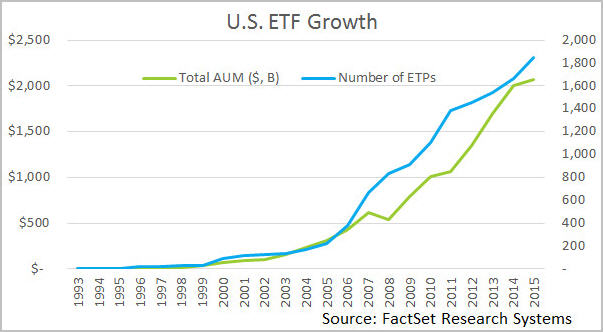There’s little question that 2015 was a stellar year for the ETF industry. Assets are at all-time highs, and a record number of new ETFs hit the market.

Despite volatile markets, ETFs pulled in $242 billion in new assets—a number that looks even more impressive when you consider that traditional mutual funds hemorrhaged $125 billion in outflows. That's a $367 billion swing in a single year, away from an old technology and towards the hot new thing.
2015 was also a record year for ETFs in terms of new issuers coming to market. We had 23 brand new ETF issuers enter the market last year, ranging from startups with cool new ideas (HACK, anyone?) to old-guard firms like John Hancock and Goldman Sachs.
And while the big keep getting bigger—Vanguard and iShares branded ETFs pulled in $180 billion in new assets—many of the smaller ETF firms had huge growth years. Deutsche Bank, WisdomTree, First Trust, Schwab all posted asset gathering numbers over 25% for the year.
With all this great news, it's easy to look forward to 2016 with rose-colored glasses and think "well, things will be even better in 2016!"
And it might. But assuming so blindly and without caveats would be a mistake.
ETFs are a disruptive force, and that's got some folks scared. There's increasing mobilization to reign in, co-opt, and alter the course of the ETF revolution. We're at a pregnant moment of the ETF revolution; things could go any number of ways. As an investor—whether you're an individual, an advisor, a portfolio manager or an ETF issuer—you're going to be asked to take sides, and participate in shaping the future.
Here are the six things I think we all need to keep our eyes on:
- ETF Liquidity: The Securities and Exchange Commission has proposals on the table (which I’ve written about before) to radically limit the kinds of securities an ETF (or mutual fund) can have on its books. There are pockets of truth behind their concerns—ETFs have opened up new asset classes, and some of them, like junk bonds or bank loans, are inherently illiquid. One way or another, the SEC will act in 2016 on ETF (and mutual fund) liquidity, and how they do it could dramatically impact your portfolio. If you think it’s a guarantee we’ll even have junk bond funds in a few years, you haven’t read their proposals.
- Leveraged & Inverse ETFs: It seems that some regulators get really nervous around leveraged ETFs, because they believe that making them available to ill-informed investors is like handing guns to babies. There’s some truth to that—consider that ETF issuer VelocityShares took in over $3 billion in new assets this year, leaving the firm with…$3 billion. Their big funds tracking triple leveraged oil and gas lost so much investor capital that all those inflows barely replaced the lost money. While these types of products are already off the approved list in most advisor platforms, my mom can still buy them in her discount brokerage account. As a result, the SEC has proposed rules that would make getting this kind of leverage impossible in traditional mutual funds and ETFs. But there are real unintended consequences if the rules get implemented as they stand, and they could remove some very useful tools from your tool chest.
- Taxes: While no presidential candidate has put a detailed tax plan on the table, and likely won’t until the summer, there’s little doubt in my mind that the taxation of investments is going to be on the table. ETFs currently enjoy an incredibly tax-efficient status because of the in-kind creation redemption process, and many ETNs offer tax-advantaged alternatives to historically tax-inefficient investments. Any investor not paying close attention here could be in for nasty surprises come 2017.
- Smart Beta and the Battle for Purity: Currency-hedged equity was one of the fastest growing categories of ETFs in 2015, and “smart beta” is the investing buzz word du jour. But with so many new entrants, it’s becoming increasingly difficult to separate the truly great alternative indexing ideas based from the snake oil. This is going to be the year where many early smart beta funds have a long enough track record to evaluate, and the results are going to be messy. I expect a shakeout in smart beta, with large numbers of fund closures.
- Market Structure: August 24th proved that the Flash Crash of 2010 wasn’t an isolated event, and ETFs are once again in the cross-hairs. While we don’t know many details beyond an inevitable re-hash of the Limit Up/Limit Down rules, it seems certain that regulators and exchanges are going to muck with the market plumbing in a meaningful way this year.
- Active Management: While it would be easy to read the latest S&P Index vs. Active (SPIVA) numbers and declare that active management is finally dead, nothing could be further from the truth. One or both of the two competing non-transparent active ETF structures will begin trading in 2016, with near certainty. With that, I think a dam will break, and we’ll see a flood of traditional, “trust me, I’m smart” active managers entering the ETF market. This brings with it real challenges for anyone who manages client money, and real challenges for how investors perceive what “ETF” means.
These six topics are incredibly important, and how they shake out in 2016 is going to fundamentally alter the ETF market. I’ll be digging into each of these in more detail in my research this coming year, and I’ll start by presenting more details and some initial suggestions on how different kinds of investors can help prepare for these changes…and for the ambitious, move things in the right direction.
Join us at the Inside ETFs conference in Hollywood, Florida later this month to learn more about this topic.
It’s going to be an interesting year.
